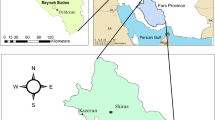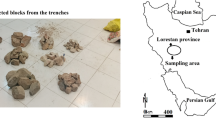Abstract
The slake durability (SD) of a rock is a vital engineering property relevant to its evaluation and estimation of its degradability due to mechanical and chemical breakdown. This study assesses the influence of pH of slaking fluid and different acidic solutions on slake durability of granitic rocks (fine-grained and porphyritic granite) by carrying out slake durability test (SDT) in acidic and basic conditions or environment. Petrographic analysis and basic laboratory tests such as porosity, water absorption capacity, density, and point load test, Schmidt rebound hammer were performed on the granitic rocks. The SDT was carried out in accordance with the standard procedure in distilled water and in different slaking fluids prepared by adding suitable amount of H2SO4 and HNO3 (representing acidic solutions) and NaOH (representing alkaline solutions) to distilled water. The SD of the granitic rocks was evaluated up to 8 cycles in acidic and basic solutions with pH ranging from 2 to 12. The slake durability index (SDI) of the granitic rocks range from very high to extremely high under the different pH and two acidic solutions. The lowest SDI was obtained when the pH of the testing fluid is 2 (both in H2SO4 and HNO3 solutions). However, as the pH of the slaking fluid > 2, the durability index of the granitic rocks becomes indistinct depending on the rock material properties rather than the slaking fluid pH. The SDI of the granitic rocks in H2SO4 solution is greater than in HNO3 solution at pH = 2. The granitic rocks have very high to extremely high durability. However, the granitic rock with coarse texture, low strength, high water absorption capacity and porosity is quite more liable to degradation in different environments.







Similar content being viewed by others
Data availability
Virtually all the Data are included in the article.
Abbreviations
- MGQC:
-
Migmatite gneiss-quartzite complex
- PBC:
-
Precambrian basement complex
- PLT:
-
Point load test
- SD:
-
Slake durability
- SDI:
-
Slake durability index
- SDT:
-
Slake durability test
- SRH:
-
Schmidt rebound hammer
References
Acker JG, Bricker OP (1992) The influence of pH on biotite dissolution and alteration kinetics at low temperature. Geochim Cosmochim Acta 56:3073–3092. https://doi.org/10.1016/0016-7037(92)90290-Y
Afolagboye LO (2021) Using index tests to predict the compressive strength of crystalline rocks. Proc Inst Civ Eng Constr Mater 174:289–297. https://doi.org/10.1680/jcoma.18.00061
Afolagboye LO, Talabi AO, Akinola OO (2016) Evaluation of selected basement complex rocks from Ado-Ekiti, SW Nigeria, as source of road construction aggregates. Bull Eng Geol Environ 75:853–865. https://doi.org/10.1007/s10064-015-0766-1
Arman H (2021) Effects of slaking fluid pH on the index properties of carbonate rocks. Geotech Geol Eng 39:5843–5855. https://doi.org/10.1007/s10706-021-01870-4
Arman H, Hussein S, Abouhaligah HEY et al (2019) Predicting weathering characteristics of carbonate rocks under different geo-environmental conditions. IOP Conf Ser Earth Environ Sci 362:012016. https://doi.org/10.1088/1755-1315/362/1/012016
Arman H, Abdelghany O, Saima MA et al (2021a) Slaking behavior of evaporitic rocks from Abu Dhabi area. United Arab Emirates Arab J Geosci 14:924. https://doi.org/10.1007/s12517-021-07295-w
Arman H, Abu Saima M, Abdelghany O, Paramban S (2021b) Comparative study on degradability characteristics of evaporitic and carbonate rocks from Al Ain, United Arab Emirates. IOP Conf Ser Earth Environ Sci 906:012130. https://doi.org/10.1088/1755-1315/906/1/012130
ASTM D4644_08 (2008) Standard Method for Slake Durability of Shales and Similar Weak Rocks. ASTM International, West Conshohocken
Bell FG (2007) Engineering geology, 2nd edn. Elsevier, Oxford
Blows JF, Carey PJ, Poole AB (2003) Preliminary investigations into Caen Stone in the UK; its use, weathering and comparison with repair stone. Build Environ 38:1143–1149. https://doi.org/10.1016/S0360-1323(03)00075-1
Elueze A (2000) Compositional appraisal and petrotectonic significance of the Imelu banded ferruginous rock in the Ilesha schist belt, southwestern Nigeria. J Min Geol 36:9–18
Erguler ZA, Shakoor A (2009) Relative contribution of various climatic processes in disintegration of clay-bearing rocks. Eng Geol 108:36–42. https://doi.org/10.1016/j.enggeo.2009.06.002
Fereidooni D, Ghobadi MH (2015) Effect of mineralogy on durability and strength of hornfelsic rocks under acidic rainfall in urban areas. J Eng 9:2765–2788. https://doi.org/10.18869/acadpub.jeg.9.2.2765
Fereidooni D, Khajevand R (2017) Correlations between slake-durability index and engineering properties of some travertine samples under wetting-drying cycles. Geotech Geol Eng 362(36):1071–1089. https://doi.org/10.1007/S10706-017-0376-8
Fereidooni D, Khajevand R (2019) Utilization of the accelerated weathering test method for evaluating the durability of sedimentary rocks. Bull Eng Geol Environ 78:2697–2716. https://doi.org/10.1007/s10064-018-1267-9
Franklin JA, Chandra A (1972) The slake durability test. Int J Rock Mech Min Sci 9:325–341
Ghobadi MH, Momeni AA (2011) Assessment of granitic rocks degradability susceptive to acid solutions in urban area. Environ Earth Sci 64:753–760. https://doi.org/10.1007/s12665-010-0895-6
Ghobadi MH, Mousavi S (2014) The effect of pH and salty solutions on durability of sandstones of the Aghajari Formation in Khouzestan province, southwest of Iran. Arab J Geosci 7:641–653. https://doi.org/10.1007/s12517-012-0741-0
Gupta V, Ahmed I (2007) The effect of pH of water and mineralogical properties on the slake durability (degradability) of different rocks from the Lesser Himalaya, India. Eng Geol 95:79–87. https://doi.org/10.1016/j.enggeo.2007.09.004
Huang L, Zhang G, Yang J (2013) Weathering and soil formation rates based on geochemical mass balances in a small forested watershed under acid precipitation in subtropical China. CATENA 105:11–20. https://doi.org/10.1016/j.catena.2013.01.002
IAEG (1979) Classification of rocks and soils for engineering geological mapping part I: rock and soil materials. Bull Int Assoc Eng Geol 19:364–371. https://doi.org/10.1007/BF02600503
ISRM (International Society for Rock Mechanics) (1978) Suggested method for petrographic description of rocks. Commission for standardization of laboratory and field tests. Int J Rock Mech Min Sci Geomech Abstr 15:43–45
ISRM (International Society for Rock Mechanics) (2007) The complete ISRM suggested methods for rock characterization, testing and monitoring: 1974–2006. In: Ulusay R, Hudson JA (eds) Suggested methods prepared by the commission on testing methods. Kozan Ofset, Ankara, Turkey, p 628
Jamshidi A, Nikudel MR, Hafezi-Moghadas N (2009) Comparison the effect of sulfuric acid and nitric acid solution on slake durability of samples from building stones. In: 12th symposium of the geological society of Iran. pp 2:120–126 (in Persian)
Khajevand R, Fereidooni D (2022) The effects of water acidity and engineering properties on rock durabilit. Earth Sci Res J 26:67–79. https://doi.org/10.15446/esrj.v26n1.76468
Kim S, Park H-D (2003) The relationship between physical and chemical weathering indices of granites around Seoul, Korea. Bull Eng Geol Environ 62:207–212. https://doi.org/10.1007/s10064-003-0192-7
Latham J-P, Wang H, Poole AB (1993) Choice of rock in maritime engineering. In: Abbott MB, Price WA (eds) Coastal, estuarial and harbour engineers reference book. Chapman and Hall, New York, pp 523–539
Momeni A, Hashemi SS, Khanlari GR, Heidari M (2017) The effect of weathering on durability and deformability properties of granitoid rocks. Bull Eng Geol Environ 76:1037–1049. https://doi.org/10.1007/s10064-016-0999-7
Pinho AB, Andrade PS, Duarte IMR (2017) Physical Weathering. In: Bobrowsky PT, Marker B (eds) Encyclopedia of engineering geology. Springer International Publishing, Cham, pp 1–5
Qi J, Sui W, Liu Y, Zhang D (2015) Slaking process and mechanisms under static wetting and drying cycles slaking tests in a Red Strata Mudstone. Geotech Geol Eng 33:959–972. https://doi.org/10.1007/s10706-015-9878-4
Schiavon N (2007) Kaolinisation of granite in an urban environment. Environ Geol 52:399–407. https://doi.org/10.1007/s00254-006-0473-0
White AF, Blum AE (1995) Effects of climate on chemical_ weathering in watersheds. Geochim Cosmochim Acta 59:1729–1747. https://doi.org/10.1016/0016-7037(95)00078-E
Yagiz S (2018) The effect of pH of the testing liquid on the degradability of carbonate rocks. Geotech Geol Eng 36:2351–2363. https://doi.org/10.1007/s10706-018-0467-1
Yavuz AB (2006) Deterioration of the volcanic kerb and pavement stones in a humid environment in the city centre of Izmir, Turkey. Environ Geol 51:211–227. https://doi.org/10.1007/s00254-006-0320-3
Zhang M, McSaveney MJ (2018) Is air pollution causing landslides in China? Earth Planet Sci Lett 481:284–289. https://doi.org/10.1016/j.epsl.2017.10.045
Zorlu K (2008) Description of the weathering states of building stones by fractal geometry and fuzzy inference system in the Olba ancient city (Southern Turkey). Eng Geol 101:124–133. https://doi.org/10.1016/j.enggeo.2008.04.005
Funding
The authors have not disclosed any funding.
Author information
Authors and Affiliations
Corresponding author
Ethics declarations
Conflict of interest
There are no conflicts of interest with regard to this manuscript.
Additional information
Publisher's Note
Springer Nature remains neutral with regard to jurisdictional claims in published maps and institutional affiliations.
Rights and permissions
Springer Nature or its licensor holds exclusive rights to this article under a publishing agreement with the author(s) or other rightsholder(s); author self-archiving of the accepted manuscript version of this article is solely governed by the terms of such publishing agreement and applicable law.
About this article
Cite this article
Afolagboye, L.O., Owoyemi, O.O. & Akinola, O.O. Effect of pH Condition and Different Solution on the Slake Durability of Granitic Rocks. Geotech Geol Eng 41, 897–906 (2023). https://doi.org/10.1007/s10706-022-02312-5
Received:
Accepted:
Published:
Issue Date:
DOI: https://doi.org/10.1007/s10706-022-02312-5




